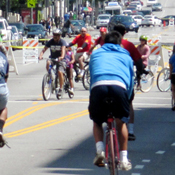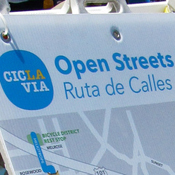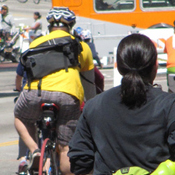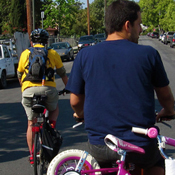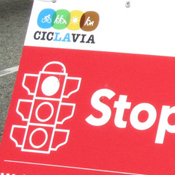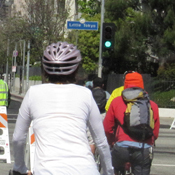Los Angeles, CA
Background
By closing streets to traffic, ciclovías help families get outside to enjoy recreational use of our largest public space – our streets. Ciclovías started in Bogotá, Colombia, over thirty years ago as a reaction to city street congestion. Now events are held throughout Latin America and the United States, connecting communities and providing relief from the stress of car traffic.
CicLAvia makes the Los Angeles streets safer for people to walk, skate, play and ride a bike. It provides a temporary free park and a corridor filled with fun simply by removing cars from public streets. Residents can explore the city and experience things that they may drive by every day, but don’t always notice – neighborhoods, historic buildings, churches, parks and public art. Other sights and experiences along the way may include musicians, dancers, costumes, political rallies, yoga, capoeira, and more. Community groups may publicize their efforts with “moving tables” that travel the route. Some activities and events are spontaneous and others are scheduled. Shops and restaurants along the CicLAvia are open for participants.
CicLAvia addresses the need for reducing air pollution and traffic congestion. It encourages physical activity that can help reduce obesity and other health conditions impacted by lack of exercise. It addresses the scarcity of public open space and the opportunity to safely utilize active transportation modes, such as bicycling, walking and skateboarding.
In 2011, CicLAvia held a very successful event that converted seven and a half miles of streets into a car-free zone from 10 a.m. - 3 p.m. The relatively level route had restrooms and watering stations along the way. Funded in part through corporate sponsorship, and event partners include the City of Los Angeles, Metro, and the Los Angeles County Bicycle Coalition, additional events were also planned in addition to the cycling.
Adapted from: CicLAvia
Lessons Learned
Potential Benefits:
- Help families get outside to enjoy recreational use of our largest public space.
- Increase the perception of Los Angeles streets being safer for people to walk, skate, play and ride a bike.
- Encourage physical activity that can help reduce obesity and other health conditions impacted by lack of exercise.
- Increase social interaction and cohesion amongst a diverse range of people.
- Allow residents and visitors to experience city streets from a different perspective.
- Provide a high visibility venue for community services to be advertised and offered.
- Stimulate economic activity.
Potential Issues and Challenges:
-
Extensive Planning: To ensure a safe and successful event, extensive planning, resources and personnel are required. These include:
- Obtaining sponsorships and creating partnerships (e.g. City of Los Angeles, Metro, and the LA Bicycle Coalition).
- Selected route needed to meet a complex number of different criteria including having local landmarks and destination spaces, traverse a range of neighborhoods that included Koreatown, Boyle Heights, Little Tokyo, Fashion District, and East Hollywood, to enhance equitable participation, be of appropriate length (no shorter than 4 km and ideally at least 10 km in length as per the Ciclovia manual), be in good condition and relatively level so that it is easy for cyclists and pedestrians to traverse, conveniently accessible by bicycle, public transit and private vehicle, and have appropriate amount of parking for cars and bicyclists.
-
Traffic and Access Impacts: The careful selection of the route and day of the event (usually weekend) ensured that the overall traffic impacts to surrounding areas are minimal despite closing a freeway off ramp. However, a number of other measures are taken to minimize any potential traffic and access impacts during the staging, break-up and duration of the event course of the event that include:
- Maintain fire and medical emergency access for the event participants
- Maintain access to nearby emergency providers including hospitals and fire stations.
- Provide alternative access to local businesses and residents for any road closures.
- Community Engagement: Extensive community engagement is needed to inform residents and businesses about the cicLAvia. These include hosting a website, door to door outreach, and using traditional and social media including blogs and twitter.
- Cost: While providing a number of benefits, the cost of planning and conducting the CicLAvia is high. It is estimated that each 10 mile CicLAvia event costs the CicLAvia non-profit organization about $350,000. CicLAvia organization covers about 40% of the costs and the City of Los Angeles covering the remaining 60%. Key cost items include initial planning, outreach and publicity, insurance and permitting, closing a freeway off ramp, accommodating and renting and staging features such as temporary barricades, signage, restrooms, water stations, assistance stations, information kiosks, bicycle parking, and hosting a central command. CicLAvia was able to minimize the cost by using volunteers and raising money through sources that included sponsorships from corporations and foundations, donations and pledges (with attractive gifts such as stickers and buttons), and sales of raffle tickets.
Sources
CicLAvia, “About” (http://ciclavia.wordpress.com/about/)
CicLAvia, http://www.ciclavia.org/
http://articles.latimes.com/2012/apr/16/local/la-me-0416-ciclavia-20120416
Photo Sources
MIG, Inc.

